|
1st
Report
2nd Report
Guangzhou
Zoo, China Report
February
20-24, 2014
Goals
The
purpose of the visit was to introduce young chimpanzees to
an adolescent female as a surrogate parent and to give
recommendations regarding basic husbandry routine and
enrichment for all species.
Chimpanzees
(Pan troglodytes ?)
Subspecies unknown.
Suggestions:
Subspecies needs to be determined by DNA testing.
 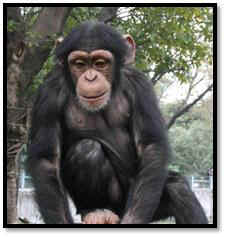
From
left to right: Huahua (female, 6 years old) and Suisui
(female, 6 years old)
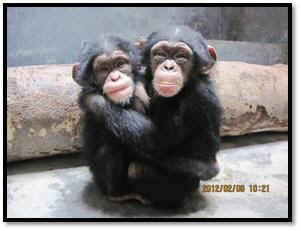
From
left to right: Obama (male, 4 years old) and
Baby girl (female, 4 years old)
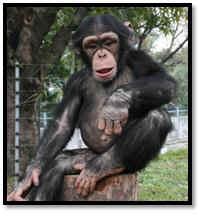 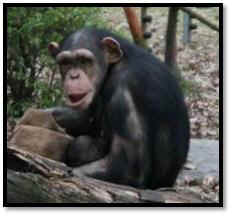
From
left to right: Yangyang (male, 4 years old) and Yingya
(female, 10 years old)
There
was also another adult female chimpanzee, Manli, housed by
herself. This chimpanzee was not introduced to the group
because she was going to be transferred to another zoo
within a few days for breeding.
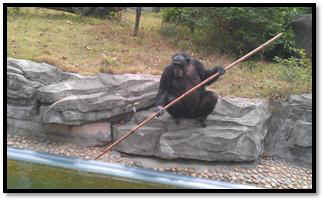
Manli
(female, 19 years old)
Chimpanzee
Introduction
The
introduction went fast and smoothly. Since the chimpanzees
were so young, they were transported from one cage to
another by their keepers.
After
adding substrate, scattered food and browse to all cages,
introduction commenced when the animals were finished
foraging and playing. Animals were introduced by a buddy
system, having familiar animals present for support and
protection.
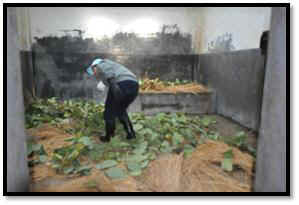 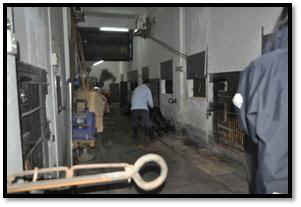
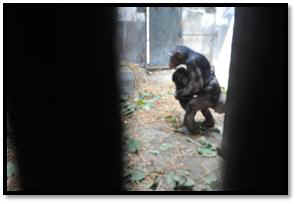 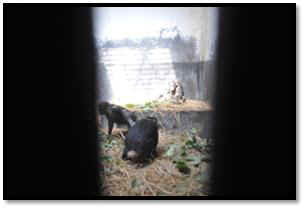

Chimpanzee
Exhibits
The
chimpanzee exhibit was satisfactory in size with natural
soil and plenty of climbing structures. Their night house
was large enough, made of concrete and metal. The animals
are locked inside during the winter.
Suggestions:
To further improve quality, some permanent furniture,
especially sleeping nests need to be installed as high as
possible in both on- and off-exhibit areas. Please review
example pictures below.
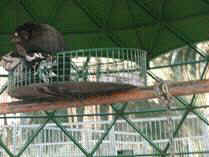 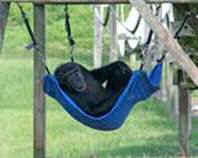 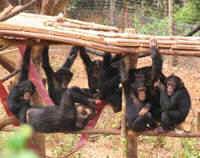
Metal
basket, hammock and platform for sleeping furniture both
inside and outside
The
night houses could utilize three dimensions by adding large
tree trunks, ropes, fire hoses, hammocks, wooden shelves,
etc. to increase space and allow opportunities for exercise,
exploration and manipulation.
Boomer
ball products are not so easy to come by in China, but
recycled household products (cereal boxes, cardboard boxes,
plastic bottles, barrels, plastic cups, old plush toys,
towels, clothing, tires, etc.) can be easily incorporated as
enrichment/toys.
It
is preferable to add more windows and/or skylights to
increase light. It would also be advantageous to build double
sliding doors (one being solid and the other one built
from bars and mesh) so that the night houses and the exhibit
could be connected with a “Round Robin” system,
allowing animals to move about in circular ways and not just
a linear fashion. This system could be used for all other
species as well and would help with introductions or with
shifting animals more easily and quickly.
Winter Care
Chimpanzees
can be allowed outside for limited time during the
winter; however, they need to have access to inside heat
and provided with extra blankets. Some institutions keep
to a temperature guideline and will only let their
chimpanzees out if the temperature reaches 10-13 C,
while others, such as Chimpanzee Sanctuary Northwest,
USA, allow the chimpanzees to make their own decision.
It is important to remember to provide chimpanzees the
opportunity to seek warmth if allowed outdoor access
during cold weather, and there might be a temperature so
low that outdoor access is inappropriate.
The only time they don't allow them outside is when
heavy, wet snow reduces the voltage on their electric
fence.
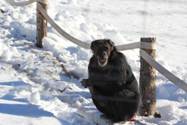 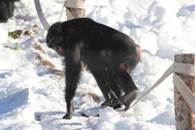 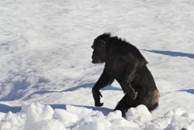
csnw chimpanzee snow
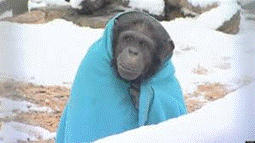
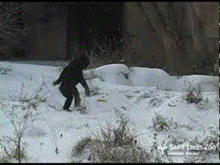
Wales
Ape and Monkey Sanctuary, U.K.
Saint Louis
Zoo, USA
General
Propositions:
Night
Houses, Off-exhibit Areas and Correct Substrate Use
Many
animals (especially carnivores and elephants) were
surrounded by green vegetation, but kept on sterile surfaces
with reduced chance for exploratory behaviours. This
practice likely originates out of good intent to keep a
clean environment for the animals, as it appears to be a
cultural inheritance that if an exhibit is not hosed
frequently, then the animals are not being well cared for.
However, this practice creates poor conditions for the
animals.
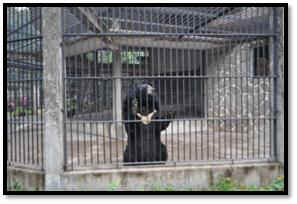 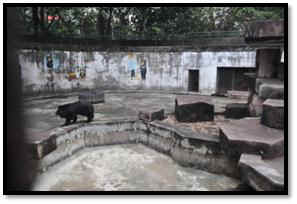
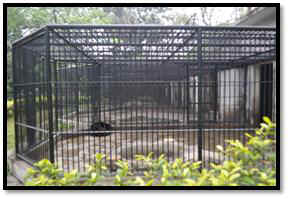 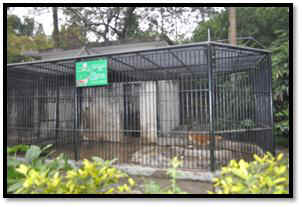
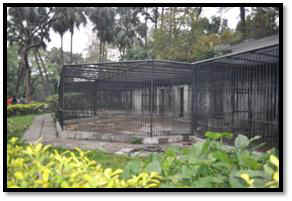 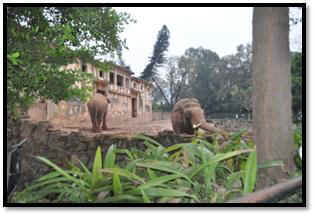
Suggestions:
Begin keeping animals off of unyielding surfaces (brick,
concrete, etc.). The use of appropriate substrate (inside-
paper products, hay or straw, etc.; outside- nonflammable
materials such as grass, sand, soil, mulch, fresh browse,
etc.) will make a significant difference not only in the
animals’ mental and physical health, but also in the
improvement of the exhibit aesthetics. Using substrate will
reduce cleaning time and water consumption, as well.
Soaking, scrubbing and hosing dry waste takes much longer
than spot cleaning substrate due to the substrate’s
ability to absorb urine and cover fecal matter. Reducing
hosing and partially covering surface with substrate will
overcome any of these obstacles and provide animals with a
soft surface.
Browse
The
zoo has a large amount of edible vegetation available on
grounds that can provide fresh, leafy branches (browse).
Suggestions:
Browse should be provided at least every 2-3 days, but if
possible, every day for animals that need it. The zoo would
benefit by planting edible trees, bushes and even
crops inside and outside of exhibits and along visitor
pathways. The bushes can provide future browsing materials
for growing collection demands. Whether cut by staff or
available by natural damage, fallen vegetation of approved
browse plants can be used rather than wasted.
Mixed
Species Exhibits
Suggestions:
Mixed species exhibits can be created in order to free up
space and create a more esthetic, complex exhibit. This will
also immediately resolve some of the solitary (otherwise
social) species problems until they are paired up with their
conspecific. Please review some photos of Phoenix Zoo mixed
exhibits:
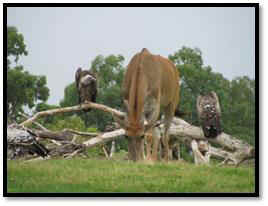 
Extending
Foraging Time
Suggestions:
All animals need to be fed in a way that extends their
foraging time and encourages appropriate, species-specific
behaviors. If no one can be appointed for this position,
staff can be scheduled to cut browse and chop diet on a
rotation basis.
Smoking
Keepers
were often observed smoking, some of them inside the night
house right next to the animals.
Suggestions:
The zoo should change its smoking policy. The first
step can be creating designated smoking areas
(tables, chairs, ashtrays, garbage cans) for visitors,
directing them to these areas to smoke. Keepers should no
longer smoke in front of the visitors at all and should
absolutely not smoke inside the animals' night houses and/or
next to the animals. Keepers also need to have
designated smoking areas behind the scenes, out of the
visitors’ view.
Animal
Performances
Removing
animals from conspecifics and hand-rearing them for
performances compromises welfare, causes a lack of social
behaviors, aggression, depression, health problems and more.
Performances
cause suffering to thousands of animals and “provide a
message that it is okay to use/abuse animals for
entertainment and demonstrates that the animals can only be
“controlled” by pain and fear” (Neale 2013).
The
removal of teeth and physical abuse that animals are
subjected to during circus-type performances are well-known
practices around the world and result in a higher
percentage of inactivity and/or increased abnormal behaviour;
i.e. self-injury and stereotypies. The lack of appropriate
social interaction, reduction in time spent foraging and the
restricted freedom to perform many highly motivated
behaviours represent stressors for circus animals. Stress
can have short-term as well as chronic long-term negative
behavioural and physiological effects. Over time this can
induce poor welfare by compromising health, altering brain
function and lowering life expectancy.


In
October 2011, Ministry of Rural and Urban Housing
Development issued a directive banning animal performances
in traditional zoos.
Nanjing, Kunming, Shanghai, Chongqing, Zhengzhou, Jinan and
Chengdu have all closed down their animal performances (Neale
2013).
Suggestions: Ending the circus-style animal performances and using current
performing animals as ambassadors for their wild
counterparts to promote species conservation and protection,
as well as improving their housing circumstances, will
demonstrate a public commitment to protecting the natural
environment, protecting animals from suffering and
protecting species from extinction.
General
Suggestions for Elephant Care
Sand needs to be added both inside the night house and on
the exhibit at a depth of one meter.
Elephants cannot be kept on concrete. It is very hard on
their feet and joints and causes severe medical problems.
Besides sand covering the floor, the elephants need a larger
pile of sand (approximately 2 meters high) to lie down
upon.

The animals should have continuous free access to
food by using feeder devices (food placed inside metal kegs
with holes, hay bags, etc.) and mostly from up high.
Hay
bags can be woven from ropes. The nets from International
Cordage are made
specifically for elephants. The zoo must contact the company
for details about rope, size, etc. The Phoenix Zoo
was the first zoo to incorporate
the nets; however our nets are prototypes.
http://www.international-cordage.net/
 
Elephants need to receive large EDIBLE tree branches
every day (please see
attached browse list for elephants).
The elephants should no longer be chained and picture
taking should be discontinued or at least reduced.
Tires can be hung from chains as enrichment.
Scratching posts made from palm trees can be chained or secured in a
safe way to the fence or the poles.

Large
tree logs (whole trees) can
be laid all over the ground to encourage the animals to step over and/or go
around them, allowing
for added exercise.

Clay wallow can
help with proper skin care and prevent sunburn.

Toys such a large Planet
Balls are available at
http://boomerball.com/
<http://boomerball.com/.


Education
The
following PowerPoint presentations were given to all staff:
Lack
of Substrate Use in Zoos addresses the easy fix of empty
cages and shows how much benefit there is to animals’
lives when provided with substrate; i.e., when they do not
have to sit inside of empty concrete cages. This is probably
the most important animal welfare presentation to give out
of the four.
Contra
Freeloading at the Phoenix Zoo talks about making
animals work for their food in similar ways as they would in
the wild, instead of eating in short periods of time from
metal dishes or rubber tubs.
Beneficial
Browse gives guidelines regarding how to develop a
zoo-wide browse program with numerous browse gardens in the
middle of the Sonoran Desert with no money. It also
addresses the major changes that fresh, leafy greens can
make in the animals’ lives.
Let Them Be Elephants addresses the
changes the Phoenix Zoo made in our elephants’ lives and
how we helped their behaviors by teaching them how to forage
right and behave like normal females. It also talks about
basic husbandry, enrichment ideas and health care.
Presentations are available at
htresz@thephxzoo.com.
I
would like to thank the Guangzhou Zoo’s director and
staff, as well as the Chinese
Association of Zoological Gardens, for
their incredible hospitality — making me feel so welcome.
I
would also like to thank Animals Asia Foundation for funding
and organizing this trip and to establish such a wonderful,
working relationship between the Jane Goodall Institute, the
Phoenix Zoo and Guangzhou Zoo.
Resources
Neale.
D. (1023). The cruelty of Animal Performances, AnimalsAsia,
Until The CrueltyEnds https://dl.dropboxusercontent.com/u/22920249/The%20cruelty%20of%20animal%20performances_nov13.pptx
Hilda
Tresz
Behavioral
Enrichment & International Animal Welfare Coordinator
Mentor,
The Jane Goodall Institute
Phoenix
Zoo | Arizona Center for Nature Conservation
455
N. Galvin Parkway | Phoenix, AZ 85008
p
602.286.3800 x 7120 | d 602.286.3820
htresz@phoenixzoo.org
| phoenixzoo.org
|







































